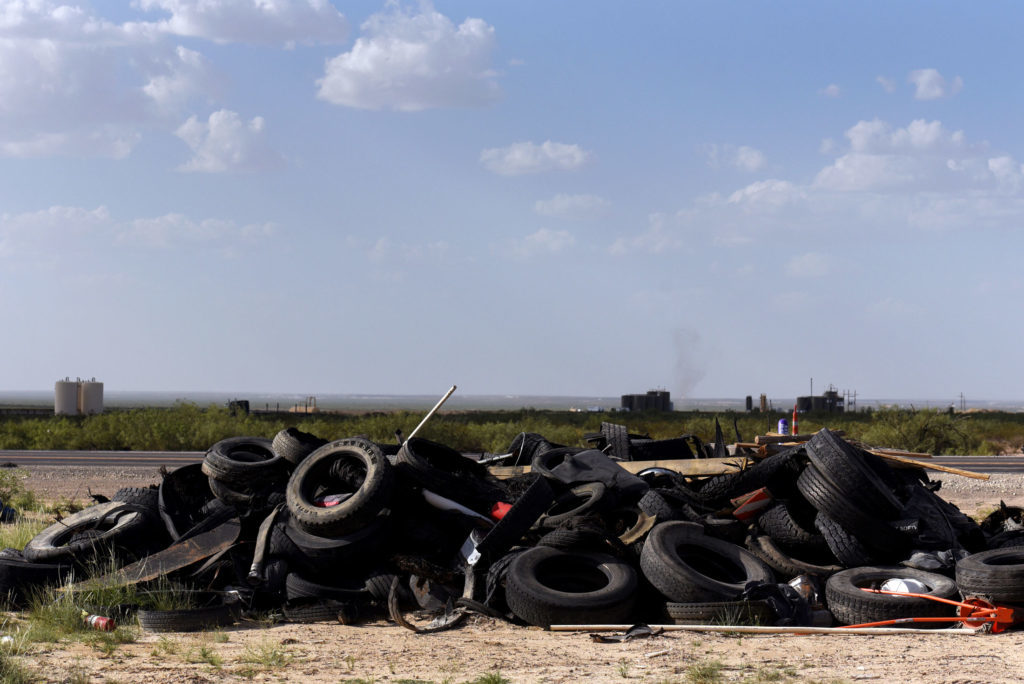
Route 285 is the formal designation for one of the main roads used to carry supplies to and from the oilfields of West Texas. Locals call it something else: “Death Highway.”
Last year, 93 people died in accidents involving trucks just on the Texas-side of the Permian Basin, or 43 percent more than in 2012. Want to know how many fatalities to expect moving forward? Keep an eye on the price of oil.
The number of traffic deaths involving big trucks shrank in 2015, when oil prices started to collapse. They surged last year as crude rallied, boosting the need for more and more truckers to manhandle the huge 18-wheelers that can carry anything from water and sand, to steel pipes and fuel.
Route 285, which runs through Pecos, Texas, and Carlsbad, New Mexico, may be “the deadliest highway in the United States,” said Ralph McIngvale, a partner at Permian Lodging, which builds and runs so-called man camps in the region. “You’ve got to be very defensive. You’ve got to look as much in your rear-view window as your front windshield.”
Drivers are so in demand in the basin that one can easily rake in $120,000 a year, Midland County Sheriff Gary Painter said in an interview. But that comes with its problems.
“Some of them are speeding, some of them are too tired to be driving, but they’re making money,” he said. “Some of these guys are just trying to make as much money as they can.”
James “Whiskey” Stroup, 57, is an experienced trucker. He pilots sand trucks now, but in the past he’s also worked as a trainer of new drivers. He knows to get the rest he needs, he said, but not everyone does.
“When you’ve been in the oilfield for ten to 11 days, working 14 hours a day, you just become so tired that you’re not thinking straight,” he said in an interview. “You’re just brain dead, because you’re living off four to six hours of sleep.”
While Stroup’s a veteran, a great many of the drivers are young, fearless and generally inexperienced. That’s why oilfield service companies look to trainers like Jeffrey Walker, coordinator of transportation training at New Mexico Junior College, to whip drivers into shape. Walker’s program gives three-week long sessions, after which drivers take a three-part test to get their Commercial Driver’s License.
The pool of drivers with at least two to three years of oilfield experience with the big rigs “has dwindled to nothing,” Walker said. Companies now are “substituting formal training for experience.”
The worst of the driving stems from over-sized trucks being on roads that weren’t designed for the amount of traffic they’re now carrying, Walker said in an interview.
In New Mexico, where Walker lives, drivers hit sinkholes that can run several feet wide, a phenomenon many people blame on fracking, Walker said. And finding funds to repair the road is a “never-ending battle,” he said.
The Texas Department of Public Safety is tackling the problem, Sergeant Oscar Villarreal said in an interview. Speed limits that were as high as 75 miles per hour have been lowered and the department has more troopers to monitor roads. But with the number of drivers growing so rapidly, he said, there’s only so much they can do.
Texas “can’t build new roads or widen roads overnight,” Villarreal said. “Those things take time. We’ve had significant growth in the area” and “the roads don’t have time to keep up.”
At the same time, the trucks used to carry oilfield supplies aren’t always properly maintained, according to Walker. “The upkeep on an oilfield truck is a lot more than an on-the-road truck,” Walker said. “Little things end up turning into big things.”
Local drivers are very aware of the risks, according to Angie Sims, a business development manager for Airswift, a workforce services company. “We travel on some very busy oilfield roads,” she said in an interview. “That’s the most dangerous part of our jobs.”
Recommended for you
